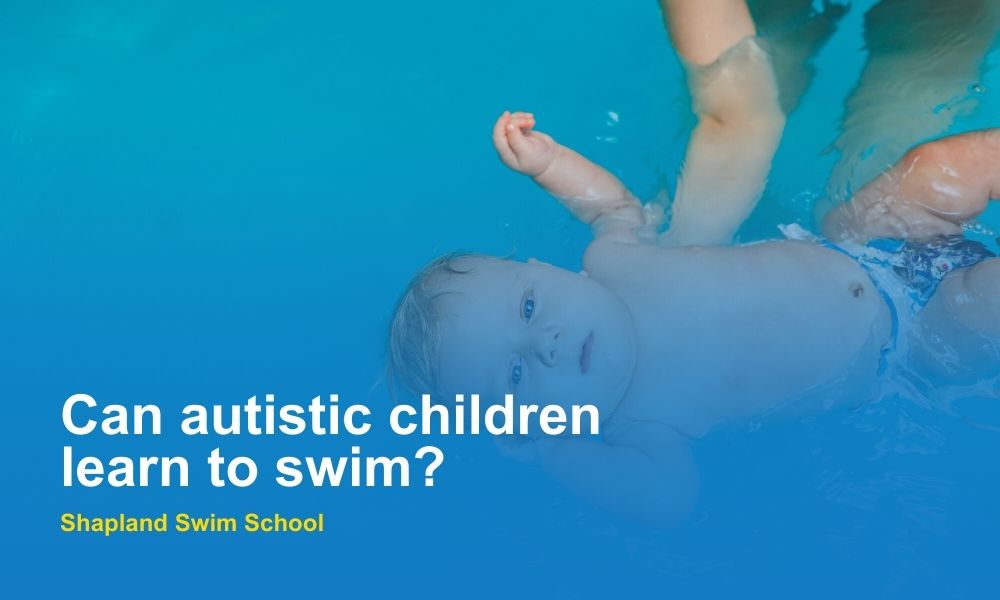Autism and swimming may seem like an unlikely combination at first, but swimming offers significant benefits for autistic children. With the right support and tailored lessons, autistic children can learn to swim, build confidence, and even thrive in the water.
April is Autism Awareness Month, making it the perfect time to highlight the importance of swimming as a therapeutic activity for children on the autism spectrum. If you’re wondering whether your child can swim or how to start, rest assured that with the proper guidance from Shapland Swim School, swimming can become an enjoyable and valuable experience.
Swimming and Autism: All You Need to Know
Swimming is an excellent therapeutic tool for autistic children, offering both physical and mental health benefits. It promotes relaxation, enhances sensory processing, and can boost motor skills in a controlled, enjoyable environment.
Benefits
Swimming offers several benefits specifically for children on the autism spectrum. Firstly, it can help with sensory processing by providing a calming effect through water’s natural resistance and buoyancy. This can assist children who may experience overstimulation in other settings.
Additionally, swimming improves coordination and motor skills, which are often areas of difficulty for autistic children. The rhythmic motions involved in swimming also promote focus and attention, while the water environment offers a safe space for them to relax and express themselves freely.
Furthermore, swimming builds confidence, helping children develop a sense of achievement when they master new skills.

Strategies
When teaching an autistic child to swim, patience and consistency are key. It is important to create a calm, supportive environment where the child feels safe and comfortable.
Begin with gradual exposure to the water, allowing the child to get used to the sensation without overwhelming them. Visual aids or verbal cues can help with understanding the steps involved. Break down each swimming technique into small, manageable tasks and celebrate progress, no matter how small. Building trust with the child and their caregiver is crucial in developing a positive relationship with water. Lastly, always use positive reinforcement to encourage their efforts and achievements.
Techniques
Techniques for teaching swimming to autistic children should focus on gentle, consistent instruction.
Start with basic water safety skills, such as floating and blowing bubbles, and build from there. For children who may struggle with coordination, introduce floatation devices to provide extra support until they develop the necessary strength. Visual schedules can also be effective, allowing the child to understand what comes next in the lesson.
It’s important to incorporate sensory breaks if the child becomes overwhelmed, giving them a chance to rest and reset before continuing. Finally, repetition is essential – practicing techniques regularly will help the child feel more confident and comfortable in the water.
Can Autistic Children Learn to Swim?
Yes, autistic children can absolutely learn to swim. With appropriate swimming programs and a supportive environment, many children on the autism spectrum successfully learn to swim.
The benefits of swimming include improved motor skills, coordination, focus, and relaxation, making it a great tool for both physical and emotional development. Programs tailored specifically for children with autism provide a slower pace and more one-on-one attention, which is critical in helping them succeed.
Shapland Swim Schools, for example, offers specialised autism swimming lessons that focus on each child’s unique needs, building skills at their own pace in a calm and supportive environment.

How Long Can Autistic Children Learn to Swim?
The time it takes for autistic children to learn how to swim can vary depending on their individual needs, abilities, and comfort levels with water. Some children may take to swimming quickly, while others may need more time to adjust.
For children who are new to swimming, it is important to note that it can take several weeks or months to feel comfortable and confident in the water. Programs that allow for flexible lessons and make-up classes can help maintain continuity and keep progress steady.
Additionally, if a child takes a long break from swimming, they may need some time to readjust, but they can always pick up where they left off with the right support. If you’re concerned about your child forgetting how to swim after a long break, Shapland Swim Schools offers programs that can help them get back into the routine with ease.
Choosing the Right Swimming Program
When selecting a swimming program for an autistic child, it’s crucial to choose one that specialises in autism swim lessons. Look for programs that offer small class sizes, ideally with no more than three children per class, allowing for more individualized attention. Certified instructors who are trained in working with children on the spectrum are essential for creating a supportive and understanding environment.
Shapland Swim Schools stands out by offering tailored lessons in a calm setting, where each child can progress at their own pace. This helps build their skills and confidence while keeping them comfortable in the water. With the right program, swimming can become a positive and rewarding experience for your child.

